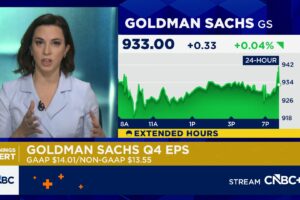This index fund offers you access to some of today’s best stocks.
If you’re just getting started along the investing path, the idea of picking your first batch of potentially winning stocks may seem intimidating. After all, it takes time and energy to research individual stocks and industries, and if you’re starting from scratch, this may look like a very big job. You could just pick up shares of today’s top-performing stocks, but you may not have the budget to invest in more than one or two — and ideally, a winning portfolio contains many stocks across industries.
Before you decide to put off this project for another day, here’s a different option to consider. With just one easy move and less than $600, you can bet on hundreds of companies that are powering today’s economy. You can do this by buying a fund that tracks the performance of the S&P 500. Here’s a closer look at this ideal way for a beginner to get into the market.

Image source: Getty Images.
Companies driving growth
Let’s start by looking at the S&P 500 and why it’s a good idea to invest in its performance. The index, as mentioned above, includes the companies driving growth today. This benchmark rebalances quarterly to ensure it includes the appropriate members, so by owning an asset that tracks it, you’ll always be invested in the most powerful companies of the times. For example, the index recently admitted Palantir Technologies, a company that’s displayed tremendous growth over the past couple of years.
Second, the S&P 500 has proven to be a winning investment by delivering an annualized return of about 10% since its beginnings in the late 1950s. If you look at the chart, below, you’ll see that the S&P 500, after tough times, has always gone on to recover and gain — so those who bet on it and stayed with it also have scored a win.
All of this means that investing in the S&P 500’s performance is a great way for newcomers to get started because it’s a pretty clear path to victory in the long run. And that equals low risk.
Now let’s consider how to actually invest in an index. You can do it by buying shares of an exchange-traded fund (ETF) that holds shares of S&P 500 members, mimicking the benchmark’s performance. But don’t worry — investing in an ETF isn’t complicated. ETFs trade daily on the market just like stocks, and you can buy them just like a stock.
Consider the expense ratio
The one main difference between owning a stock versus an ETF is an ETF comes with fees. The expense ratio is where you’ll find the details. To maximize your gains over time, choose an ETF with an expense ratio of less than 1%.
The SPDR S&P 500 ETF Trust (SPY 0.43%) fits the bill, with an expense ratio of 0.09% and exposure to top companies that have soared in recent months — from tech giants Nvidia and Meta Platforms to pharma powerhouse Eli Lilly. The information technology industry is heavily weighted at 32%, but the fund also includes 10 other sectors, which ensures you’re getting plenty of diversification. This is important because if one particular sector suffers, another may compensate.
Considering the S&P 500’s mission to include the key companies of the day, you can be certain that if one day another industry generates more growth, it will rise to the top of the index — and the SPDR fund will mimic the move. So this investment offers you some important elements to support long-term success: diversification, flexibility, and exposure to the top names of the moment. And this formula has worked over the long run.
Don’t forget stock picking
Of course, your investing path shouldn’t stop here. It’s a great idea to set aside time to research individual companies and add some quality stocks to your portfolio — and you can do this progressively at your own pace. This could offer your portfolio a significant boost. For example, direct holders of Nvidia locked in the company’s 165% gain so far this year, while the SPDR Index fund, which includes Nvidia shares, is heading for a 22% increase.
Holding a solid S&P 500 index fund, along with investing in individual stocks, is a great strategy. Buying the SPDR S&P 500 ETF Trust is a fantastic way to get started on this road to building wealth.
Randi Zuckerberg, a former director of market development and spokeswoman for Facebook and sister to Meta Platforms CEO Mark Zuckerberg, is a member of The Motley Fool’s board of directors. Adria Cimino has no position in any of the stocks mentioned. The Motley Fool has positions in and recommends Meta Platforms, Nvidia, and Palantir Technologies. The Motley Fool has a disclosure policy.












